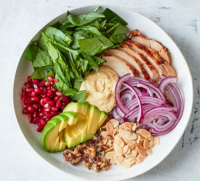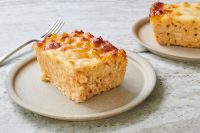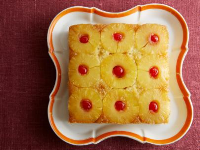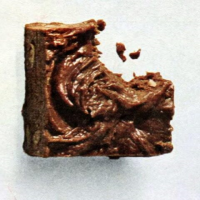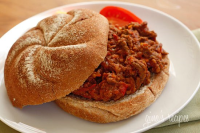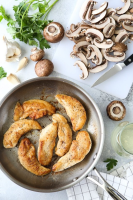HOW TO MAKE SOURDOUGH BREAD RECIPE - BBC GOOD FOOD
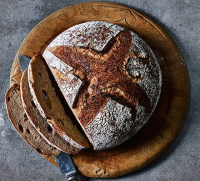
Make our easy sourdough starter seven days ahead to make our simple homemade sourdough loaf. Serve with your favourite casseroles or soups
Provided by Good Food team
Categories Side dish
Total Time 1 hours 40 minutes
Prep Time 1 hours
Cook Time 40 minutes
Yield Makes 1 loaf (cuts into 10 slices)
Number Of Ingredients 6
Steps:
- To make the sourdough starter, whisk 50g strong white flour and 50g strong wholemeal flour with 100ml slightly warm water until smooth. Transfer to a large jar or plastic container. Leave the lid ajar for 1 hr or so in a warm place, then seal and set aside for 24 hrs. For the next six days, you will need to ‘feed’ it. Each day, tip away half the original starter, add an extra 25g of each flour and 50ml slightly warm water, and stir well. After a few days, you should start to see bubbles on the surface, and it will smell yeasty. On day seven, the starter should be bubbly and smell much sweeter. It is now ready to be used, but make sure you keep half back and carry on feeding for your next loaf.
- Tip both the flours, 300ml warm water and the starter into a bowl, stir with a wooden spoon into a dough and leave somewhere for an hour.
- Tip in 25ml more water and the salt and bring everything together. Cover and leave somewhere warm for 3 hrs, folding the dough onto itself several times in the first hour. The dough should increase in size by about a third.
- Line a medium bowl with a clean tea towel and flour it really well, or flour a proving basket. Tip the dough back onto your work surface, shape into a tight, smooth ball and dust it with flour.
- Place the dough, seam-side up, in the bowl or proving basket, and leave at room temperature for 3 hrs – or better still in the fridge overnight – until risen by about a quarter.
- Heat oven to 230C/210C fan/gas 8 and put a casserole dish with a lid or a baking stone in the oven for at least 30 mins to heat up, and a large roasting tin filled with boiling water underneath. After 30 mins, carefully remove the casserole dish, invert the loaf into it and slash the top. Cover and bake for 20 mins, then take the lid off and bake for another 20 mins. Or invert onto the baking stone, slash and bake for 40 mins, or until the crust is as dark as you like it.
Nutrition Facts : Calories 202 calories, FatContent 1 grams fat, SaturatedFatContent 0.2 grams saturated fat, CarbohydrateContent 41 grams carbohydrates, SugarContent 0.3 grams sugar, FiberContent 2 grams fiber, ProteinContent 7 grams protein, SodiumContent 0.9 milligram of sodium
BASIC SOURDOUGH BREAD RECIPE | SIMPLE HOMEMADE SOURDOUG…
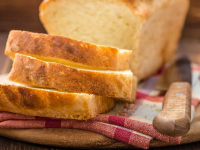
Provided by admin
Prep Time 30 minutes
Cook Time 30 minutes
Number Of Ingredients 16
Steps:
- Mix sourdough starter, flour, and salt together. Use enough water to make bread dough. (A moist dough is preferable to a dry dough.)
- Knead dough until it passes the “window pane test”: a small piece of dough will stretch between four fingers without breaking thin enough to allow light to pass through.
- Shape the dough into a loaf. Place in a pan or proofing basket, or on a board. Rub a little oil on the top surface of the dough and cover lightly with a towel or plastic wrap. Allow the dough to rise for 4-24 hours. If desired, a short (4-12 hours) proofing period can be used and the dough can be punched down, reshaped, and allowed to rise a second time, but a second proofing period is not required.
- Slice an X shape in the top of the loaf with a very sharp knife or razor blade.
- Bake at 400°F until the internal temperature reaches 210°F. (Use a meat thermometer inserted into the bottom or side of the loaf.) Bake 30-60 minutes (depending on loaf size). Cool before slicing.
More about "homemade sourdough bread starter recipes"
SOURDOUGH BREAD | JAMIE OLIVER RECIPES
Making your own sourdough takes a bit of prep and know-how, but once you’ve got the knack and start developing your instincts, you’ll be hooked!
From jamieoliver.com
Total Time 50 minutes
Cuisine https://schema.org/LowLactoseDiet, https://schema.org/VeganDiet, https://schema.org/VegetarianDiet
Calories 160 calories per serving
From jamieoliver.com
Total Time 50 minutes
Cuisine https://schema.org/LowLactoseDiet, https://schema.org/VeganDiet, https://schema.org/VegetarianDiet
Calories 160 calories per serving
- The night before you want to bake, make the levain starter. Pour 50ml of tepid water into a large mixing bowl. Use your fingers to gently stir in the mature sourdough starter until fully dissolved, then repeat with the flour until smooth and combined.
- Leave, covered, in a warm place for at least 8 hours – it’s ready when lots of bubbles appear on the surface and the dough has a milky-sweet aroma.
- The next day, to make the final dough, pour 325ml of tepid water into a large mixing bowl and add 100g of the levain, which should float (the remaining levain can be fed and used as a new sourdough starter, or gifted to a friend). Use your fingers to gently stir it into the water until fully dissolved, then repeat with both flours. Cover with a damp cloth and rest in a warm place for 1 hour.
- Now add the salt and 25ml of tepid water, scrunching them into the dough until fully combined. Set aside, covered, in a warm place for 30 minutes.
- Wet your hand slightly and give the dough four folds in the bowl, one at each ‘corner’. This is one turn. Repeat this process another three times at 30-minute intervals, turning the dough four times in total across 2 hours. After the last turn, cover and leave to rise in a warm place for another 2 hours.
- To shape the loaf, tip the dough onto a clean surface and gently dust the top with a handful of semolina flour. Roughly shape into a round, being careful to keep as much air in the dough as possible. Rest, covered, for 30 minutes.
- Dust a basket or cane banneton with semolina flour (or you can simply use a medium bowl lined with a clean, floured tea towel). Lightly flour the dough again and flip it over, so the flour side is on the worktop. Set the dough in front of you and gently shape into a round. Turn the dough over, then place it in your floured basket, banneton or tea towel-lined bowl.
- Cover the dough with a shower cap (or oiled cling film) and allow to rest for 1 to 2 hours, or until increased in size by a quarter and looking bubbly. Transfer your dough, in its basket or bowl, to the fridge to rise for another 12 to 16 hours, or until bubbly and risen by another quarter.
- Place a heavy lidded casserole pot on the bottom shelf of the oven, then preheat to full whack (240ºC/464ºF/gas 9).
- Bring your loaf out of the fridge and scatter semolina over the top. Working carefully, remove the hot pot from the oven, take off the lid and gently tip your dough out into the pot, so now the pattern should be the right way up. Score it with a sharp knife, holding it at a 40 degree angle to the surface of the dough for the best slashes, then carefully cover and return to the oven.
- Reduce the temperature to 230ºC/446ºF/gas 8 and bake for 30 minutes. Carefully remove the lid and bake for a final 20 minutes, or until a malted golden brown. Remove to a wire rack to cool.
See details
SOURDOUGH BREAD RECIPE: HOW TO MAKE IT - TASTE OF HOME
This no-knead sourdough bread is delicious. It has a crisp crust and distinctive sourdough flavor from the "starter" yeast mixture you stir up in advance. I was surprised at how easy it is! —Evelyn Gebhardt, Kasilof, Alaska
From tasteofhome.com
Reviews 4.8
Total Time 01 hours 05 minutes
Calories 120 calories per serving
From tasteofhome.com
Reviews 4.8
Total Time 01 hours 05 minutes
Calories 120 calories per serving
- In a 4-qt. non-metallic bowl, dissolve yeast in 2 cups warm water; let stand 5 minutes. Stir in 2 cups flour until smooth. Cover loosely with a clean towel. Let stand in a warm place (80°to 90°) to ferment for 48 hours; do not stir. (The mixture will become bubbly and rise, have a "yeasty" sour aroma and change color from transparent yellow to gray over the course of 48 hours.) , Stir in milk powder, butter, sugar, salt, remaining water and enough remaining flour to form a soft dough. (Do not knead.) Cover and let rise in a warm place until doubled, about 1-1/2 hours. , Heavily grease baking sheets and sprinkle with cornmeal. Gently punch dough down. Turn onto a well-floured surface; divide in half. (If baking loaves one at a time, cover and refrigerate half of dough. Proceed with shaping and second rise when oven is ready so shaped loaf can be baked immediately after the second rise.) , With floured hands, gently move the dough in a circular motion. Use friction from the counter to stretch the surface and create a smooth top and round loaf. Quickly and gently transfer to prepared pans. Cover and let rise until doubled, about 30 minutes. Preheat oven to 375°., With a sharp knife, make three diagonal slashes across tops of loaves. Immediately bake 10 minutes. Gently brush or spray loaves with cold water; bake 25-35 minutes longer or until golden brown.
See details
HOW TO MAKE SOURDOUGH BREAD - NYT COOKING
Perhaps you’ve seen impressively holey sourdough loaves on social media, and wondered if you too could make them. You can! Claire Saffitz can show you how.
From cooking.nytimes.com
From cooking.nytimes.com
- Keep your starter in a container with the lid on, labeled clearly. Once a week, discard all but 25 grams of starter (discarding most of the starter helps avoid building up a massive amount with each successive feeding). Using a digital scale for accuracy, stir 100 grams of room temperature tap water into the starter until the starter is evenly dispersed. Then stir in 100 grams of high-quality white bread flour until you have a smooth paste. Cover and place in the back of the refrigerator. Set a calendar reminder to feed your starter at the same time every week. Why? The yeast and bacteria in starter feed on sugars in the flour, and you’ll need to replenish this food source on a regular basis. Cooling it down will significantly slow the level of activity, or how quickly the micro-organism consume its food source. Bakeries generally keep their starter at room temperature and feed it at least once a day because they are mixing and baking dough constantly, but for most home bakers, refrigerating your starter and feeding it once a week is sufficient. Think of it as a low-maintenance pet!
See details
BEST SOURDOUGH BREAD RECIPE - HOW TO MAKE ... - DELISH
Reward yourself with fresh homemade Sourdough Bread with this recipe from Delish.com.
From delish.com
Reviews 4.7
Total Time 19 hours
Category dairy-free, low-fat, low sugar, nut-free, vegan, vegetarian, brunch, picnic, weeknight meals, baking, breakfast, brunch, side dish
Cuisine American
From delish.com
Reviews 4.7
Total Time 19 hours
Category dairy-free, low-fat, low sugar, nut-free, vegan, vegetarian, brunch, picnic, weeknight meals, baking, breakfast, brunch, side dish
Cuisine American
- On day 2
See details
SOURDOUGH BREAD | JAMIE OLIVER RECIPES
Making your own sourdough takes a bit of prep and know-how, but once you’ve got the knack and start developing your instincts, you’ll be hooked!
From jamieoliver.com
Total Time 50 minutes
Cuisine https://schema.org/LowLactoseDiet, https://schema.org/VeganDiet, https://schema.org/VegetarianDiet
Calories 160 calories per serving
From jamieoliver.com
Total Time 50 minutes
Cuisine https://schema.org/LowLactoseDiet, https://schema.org/VeganDiet, https://schema.org/VegetarianDiet
Calories 160 calories per serving
- The night before you want to bake, make the levain starter. Pour 50ml of tepid water into a large mixing bowl. Use your fingers to gently stir in the mature sourdough starter until fully dissolved, then repeat with the flour until smooth and combined.
- Leave, covered, in a warm place for at least 8 hours – it’s ready when lots of bubbles appear on the surface and the dough has a milky-sweet aroma.
- The next day, to make the final dough, pour 325ml of tepid water into a large mixing bowl and add 100g of the levain, which should float (the remaining levain can be fed and used as a new sourdough starter, or gifted to a friend). Use your fingers to gently stir it into the water until fully dissolved, then repeat with both flours. Cover with a damp cloth and rest in a warm place for 1 hour.
- Now add the salt and 25ml of tepid water, scrunching them into the dough until fully combined. Set aside, covered, in a warm place for 30 minutes.
- Wet your hand slightly and give the dough four folds in the bowl, one at each ‘corner’. This is one turn. Repeat this process another three times at 30-minute intervals, turning the dough four times in total across 2 hours. After the last turn, cover and leave to rise in a warm place for another 2 hours.
- To shape the loaf, tip the dough onto a clean surface and gently dust the top with a handful of semolina flour. Roughly shape into a round, being careful to keep as much air in the dough as possible. Rest, covered, for 30 minutes.
- Dust a basket or cane banneton with semolina flour (or you can simply use a medium bowl lined with a clean, floured tea towel). Lightly flour the dough again and flip it over, so the flour side is on the worktop. Set the dough in front of you and gently shape into a round. Turn the dough over, then place it in your floured basket, banneton or tea towel-lined bowl.
- Cover the dough with a shower cap (or oiled cling film) and allow to rest for 1 to 2 hours, or until increased in size by a quarter and looking bubbly. Transfer your dough, in its basket or bowl, to the fridge to rise for another 12 to 16 hours, or until bubbly and risen by another quarter.
- Place a heavy lidded casserole pot on the bottom shelf of the oven, then preheat to full whack (240ºC/464ºF/gas 9).
- Bring your loaf out of the fridge and scatter semolina over the top. Working carefully, remove the hot pot from the oven, take off the lid and gently tip your dough out into the pot, so now the pattern should be the right way up. Score it with a sharp knife, holding it at a 40 degree angle to the surface of the dough for the best slashes, then carefully cover and return to the oven.
- Reduce the temperature to 230ºC/446ºF/gas 8 and bake for 30 minutes. Carefully remove the lid and bake for a final 20 minutes, or until a malted golden brown. Remove to a wire rack to cool.
See details
8 SOURDOUGH BREAD RECIPES THAT USE A STARTER | ALLRECIPES
Apr 08, 2020 · Starter is what makes homemade sourdough bread so unique, because it doesn't require commercial yeast in order to rise. A live fermented culture of flour and water, otherwise known as sourdough starter …
From allrecipes.com
From allrecipes.com
See details
SOURDOUGH BREAD RECIPES | ALLRECIPES
Fragrant sourdough bread made in an air fryer. This method is perfect for the hot months when you don't want to heat up the kitchen but still want fresh homemade sourdough. The bread …
From allrecipes.com
From allrecipes.com
See details
BEST, EASIEST HOMEMADE BREAD RECIPES - ALEXANDRA'S KITCHEN
Sourdough Bread Recipes. If you can make yeast bread, you can make sourdough. While sourdough requires a bit more time than yeast-leavened bread, most of the time is hands-off, and the result — a tangy, open-crumbed loaf of bread …
From alexandracooks.com
From alexandracooks.com
See details
HOW TO MAKE SOURDOUGH BREAD (A BEGINNERS GUIDE) | LITTLE ...
Jan 04, 2020 · Beginners Sourdough Bread; More easy sourdough bread recipes; What is sourdough bread? Sourdough bread is slow fermented, naturally-leavened bread. Instead of using commercial yeast, a sourdough starter is used to make the bread rise. A sourdough starter …
From littlespoonfarm.com
From littlespoonfarm.com
See details
HOW TO MAKE SOURDOUGH BREAD | SOURDOUGH BREAD RECIPE & HO…
How to Make a Sourdough Starter. If you need a sourdough starter, there are several ways to obtain one. Learn more about How to Obtain or Make a Sourdough Starter to decide which option is best for you. Preparing Your Starter for Baking. Baking light, fluffy sourdough bread requires fresh, active sourdough starter…
From culturesforhealth.com
From culturesforhealth.com
See details
60+ ZERO WASTE SOURDOUGH STARTER DISCARD RECIPES - NO ...
Mar 31, 2021 · 1. Mix flour, sourdough starter, cheese, melted butter, and hot sauce together.. 2. Form into a smooth, cohesive ball of dough.. 3. Split dough in half and shape into two rectangular …
From nowastenutrition.com
From nowastenutrition.com
See details
75 SOURDOUGH RECIPES TO TRANSPORT YOUR SENSES TO TAST…
You can’t list delicious sourdough recipes without including a recipe for basic sourdough bread. This recipe is excellent for making sandwich bread. The next time you have a desire for a delicious sandwich, don’t run to the store. Reach for these sourdough recipes and your sourdough starter. Well, you now have 75 different sourdough recipes.
From morningchores.com
From morningchores.com
See details
MY GO-TO SOURDOUGH BREAD RECIPE | HOW TO ... - BLESS THIS …
Nov 23, 2021 · The Best Homemade Sourdough Bread Recipe. I can't believe I'm finally sharing my sourdough recipes with you! I planned on doing a bunch of these staple recipes this fall when …
From blessthismessplease.com
From blessthismessplease.com
See details
ARTISAN SOURDOUGH BREAD RECIPE (START-TO-FINISH VIDEO) …
Feb 17, 2020 · Sourdough Starter: The Basics. To make homemade sourdough bread, you’ll need an active, mature sourdough starter. I recommend The Perfect Loaf’s sourdough starter guide or Baker Bettie’s beginner guide.. You can also ask a fellow baker or bakery for some starter …
From abeautifulplate.com
From abeautifulplate.com
See details
11 SOURDOUGH DISCARD RECIPES - THE SPRUCE EATS
Oct 26, 2020 · A sourdough starter is easy to mix up, but takes some love and attention to maintain. It's worth the effort to regularly feed your starter since the mixture adds incredible flavor and nutrition to bread. And while most sourdough products are rustic loaves of tangy bread, starter …
From thespruceeats.com
From thespruceeats.com
See details
ARTISAN SOURDOUGH BREAD RECIPE (START-TO-FINISH VIDEO) …
Feb 17, 2020 · Sourdough Starter: The Basics. To make homemade sourdough bread, you’ll need an active, mature sourdough starter. I recommend The Perfect Loaf’s sourdough starter guide or Baker Bettie’s beginner guide.. You can also ask a fellow baker or bakery for some starter …
From abeautifulplate.com
From abeautifulplate.com
See details
LONG-FERMENTATION SOURDOUGH BREAD RECIPE | ALLRECIPES
Combine 2 cups flour, water, sourdough starter, butter, sugar, and salt in a bowl. Mix into a stiff batter. Beat for a few minutes using a wooden spoon or an electric mixer; the dough should be …
From allrecipes.com
From allrecipes.com
See details
















